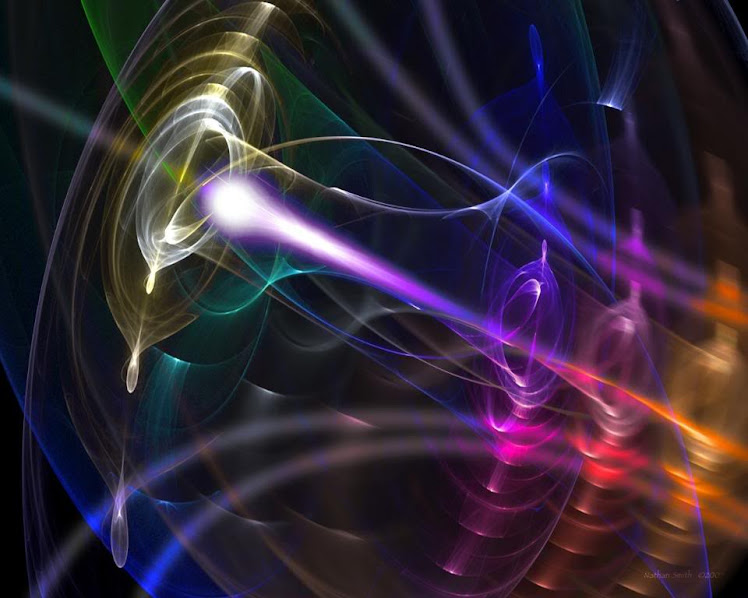The human nervous system is divided into a central and an autonomic nervous system. The autonomic is divided into parasympathetic (PNS*) and sympathetic nervous systems (SNS). The parasympathetic nervous system is divided by a gap between the vagus nerve and the kundalini. This division is symbolised in the instrument as the void (IV). The left and right sympathetic nervous systems (SNS) we use for our day to day physical, mental and emotional activity. Within the subtle instrument, Ida Nadi (Left Channel) manifests the left SNS* and Pingala Nadi (Right Channel) the right SNS. By-products of Ida Nadi activity create the balloon of superego in the head, beginning on the left at throat level and mostly covering the back and right side of the head. Pingala Nadi activity creates another balloon, of ego on the other side, covering the front and left side of the head.
The central channel of Sushumna Nadi manifests the PNS*. This system is self-governing. The Self or Spirit witnesses the action of the PNS which controls our involuntary activities such as heartbeat, breathing and reflex, that is, unconscious as opposed to conscious activity. Although we can to a degree control our sympathetic action, for instance we can make our hearts beat faster, we cannot consciously slow the heart down, which is parasympathetic action.
The Self existing at this level means that we cannot achieve Self-realisation through our own effort, only through God’s desire. Spirit is spontaneous; as natural and vital to us as our heartbeat. How long would we last if it were only our will that kept our hearts beating, or if we were to learn breathing from a book ? The spirit is infinite, while our rationality is finite, hence our efforts are also finite. Only Kundalini can bridge that great divide between illusion and reality. She is the trigger of divine bliss, that unites the attention to the Spirit, and carries you on into joy. The energy of Ida crosses with that of Pingala like a double helix. When clear and balanced, both of these nadis carry prana to Shushumna nadi, the central nadi that runs from the base of the spine to the crown of the head. At the base of Shushumna lies our Kundalini wrapped around Shakti holding her in place. When prana enters our systems, it unwinds our Kundalini allowing Shakti to travel to Shiva. When Shiva and Shakti unite we can experience oneness, the state of Samadhi, or what Tantrikas call the experience of nothingness (all things at once).
The IDA Nadi (Moon Line, Left Channel)
Qualities: tamo guna, past, subconscious
Gross expression: left sympathetic nervous system
Place on hand: whole left hand
Manifestations: auspiciousness, emotion, existence, joy, desire.
Causes of catch: lethargy, habits, conditioning, superstition, blind faith, guilt, fear, self pity, day-dreaming, drugs, bad childhood, gross attachments to children, sexual perversion, black magic.
Gross expression: left sympathetic nervous system
Place on hand: whole left hand
Manifestations: auspiciousness, emotion, existence, joy, desire.
Causes of catch: lethargy, habits, conditioning, superstition, blind faith, guilt, fear, self pity, day-dreaming, drugs, bad childhood, gross attachments to children, sexual perversion, black magic.
The left channel (“Ida Nadi” in Sanskrit) is also called the Moon Channel. It begins at the Mooladhara (1st chakra) and runs up the left side, crossing over at the Agnya Chakra (6th center) into the temple and superego on the right side of the brain. It provides the conduit for the energy of our desire.
From these desires or wishes, our emotions are triggered. Emotions are actually desires that have not yet materialized. These desires and the attendant feelings about them travel through this left channel to the appropriate places in the body to bring about the actions of fulfillment. Our desires are essential for action. Without their impetus we would have nothing to act upon.
The greatest quality of the left side is to provide joy which is the steady condition of the Spirit. You may remember having this joy as a child, or you may have observed it in small two- or three-year-old children. They usually wake up in the morning happy. While they may experience physical and emotional pain once in a while throughout their day, they do not cling to it with memory. Rather, they cry, recover, and resume the steady state of joy. The desire for this joy is still alive inside us the same as it was when we were infants. It may be blocked or covered with "tarnish" from emotional or physical injuries experienced in living life. Earlier we did not have effective techniques for clearing away the hurts and blows that are normal in living active life. The different practices help us remove those old tensions and recover that joy as a steady state of being.
Problems of the left side tend to result in passivity or emotional extremism whereby we are thrown between elation and depression. With this type of imbalance, self-discipline becomes difficult and bad habits become hard to correct. In the worst case, we become lethargic and self-obsessed. Because this channel feeds also into the skull area, pressure on the brain becomes excessive. This cycle is what causes such problems as mental breakdown, epilepsy, and senility (decay of the brain).
The state of the left channel is felt on the left side of the body. In the beginning it is most easily felt on the left palm.
To correct a weak left side we have to first balance it with the right (rajo guna). This means activity which develops the ego and pushes the over-developed superego back to the central area of the head. So we put more attention outside, on work and action. Discarding all ideas of self-destruction and self-pity, we materialise the emotional side which is attuned to our sustenance (dharma). By using the neglected right side, we bring the left into balance with the rest of the being. Now when Kundalini is raised she does not fall again.
The real and greatest quality of the left side is to give us joy (anand), which is beyond the duality of happiness and sorrow. The Spirit is always in joy. That joy is expressed in its purity when Kundalini enlightens the attention with the Spirit. Actually the joy which is latent in creation starts manifesting through our left side. Then you find joy radiating from any source of divine vibrations.
Your priorities change automatically. Old habits and addictions are over and done with, given up without difficulty. A sense of security is established and all guilt and imaginary fears disappear. ‘Everything created by nature gives a new meaning and one starts enjoying the genuine significance of every ripple of joy they emit.’
Are you curious to know what happens during the time that Ida is dominant? Contrary to Pingala, which brings out the mathematician, the financier, the lawyer in us, when Ida is dominant, the artist, the singer, the novelist, or the chef manifests. Ida is associated with the energy of the moon, which is creative, feminine, restful, calming, cooling, and healing. Lunar qualities bring out the Mother Nature (Shakti) force.
EXERCISE : Anulom Vilom - Alternate Nostril Breathing Instructions
This is a form of Pranayma, or yogic breathing that balances and cleanses the body’s energy system.
Form the Chin Mudra with the left hand by touching the tip of the left index finger to the tip of the left thumb while keeping the remaining three fingers straight. Form the Vishnu Mudra with the right hand by keeping the right index and third fingers straight, bending the right fourth and baby fingers toward the palm, and touching the tip of the right thumb to the bottom corner of the right fourth nail. Inhale, then close the right nostril with the right thumb. Exhale to a count of eight through the left nostril, inhale to a count of four through the left nostril, hold the breath for a count of sixteen, by gently squeezing the fourth and fifth fingers and the thumb against the nostrils, then switch nostrils on the exhale and exhale through the right nostril for a count of eight. This is one half-round. Complete the round by inhaling through the right for a count of four, hold the breath for a count of sixteen, then exhale through the left nostril for a count of eight. Each time you exhale, switch nostrils. Each time you exhale through the left nostril, you have completed one round. Do five rounds to begin, and gradually increase the number of rounds.
Form the Chin Mudra with the left hand by touching the tip of the left index finger to the tip of the left thumb while keeping the remaining three fingers straight. Form the Vishnu Mudra with the right hand by keeping the right index and third fingers straight, bending the right fourth and baby fingers toward the palm, and touching the tip of the right thumb to the bottom corner of the right fourth nail. Inhale, then close the right nostril with the right thumb. Exhale to a count of eight through the left nostril, inhale to a count of four through the left nostril, hold the breath for a count of sixteen, by gently squeezing the fourth and fifth fingers and the thumb against the nostrils, then switch nostrils on the exhale and exhale through the right nostril for a count of eight. This is one half-round. Complete the round by inhaling through the right for a count of four, hold the breath for a count of sixteen, then exhale through the left nostril for a count of eight. Each time you exhale, switch nostrils. Each time you exhale through the left nostril, you have completed one round. Do five rounds to begin, and gradually increase the number of rounds.



